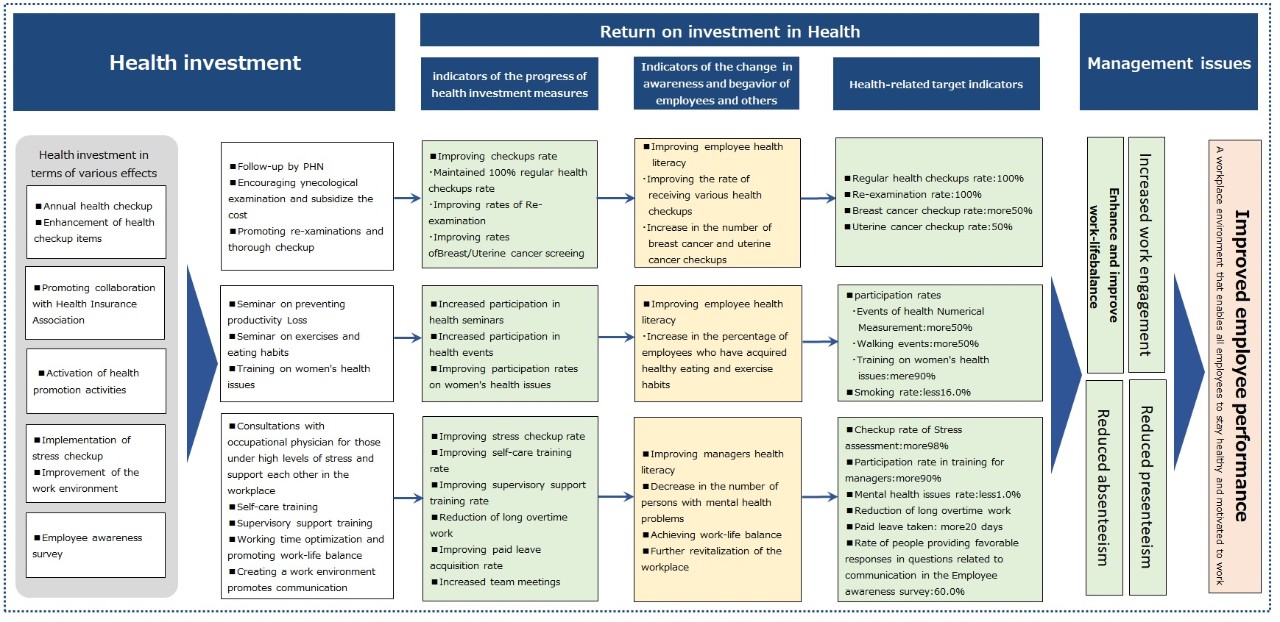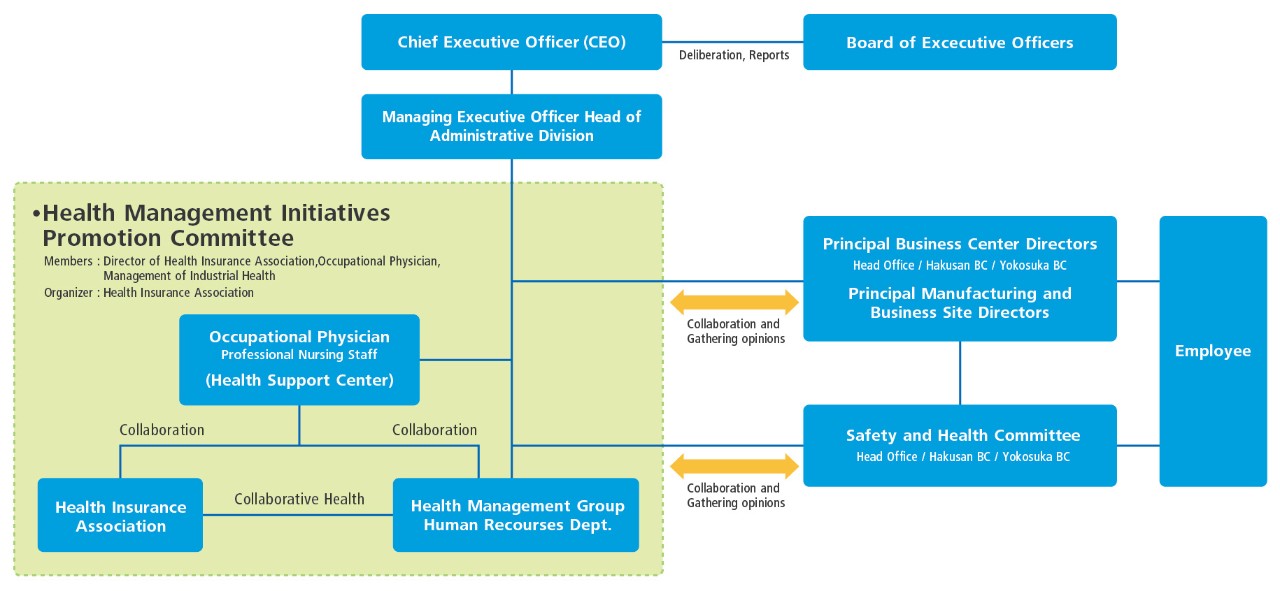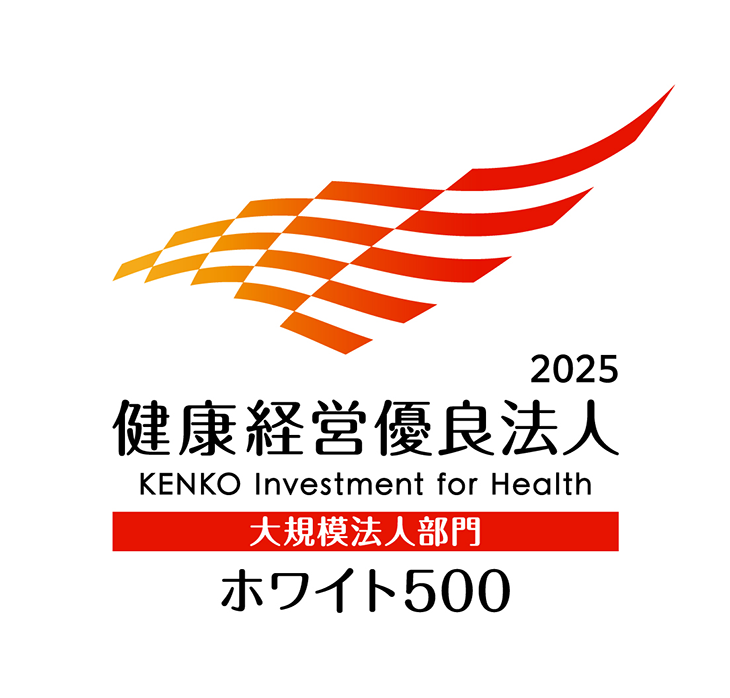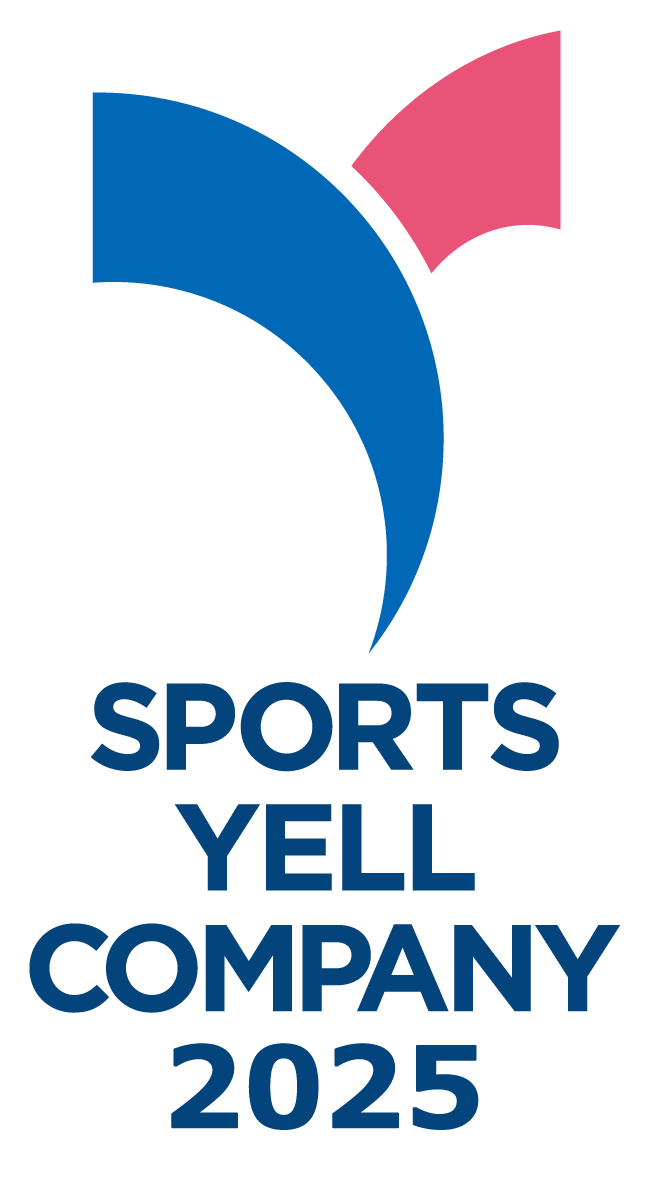Health and Productivity Management
Health and Productivity Management Initiatives
Health and Productivity Management Promotion: Purpose
In order to realize the corporate vision of “creating excitement and peace of mind for the people of the world,” JVCKENWOOD promotes “innovation” and “growth.” Recognizing our employees as the source for achieving our vision, and their mental and physical health as significant management issue, we published the JVCKENWOOD Health Policy Statement. JVCKENWOOD will aim to create a “workplace environment that enables all employees to stay healthy and motivated to work” in a sustainable manner.
JVCKENWOOD Health Policy Statement
JVCKENWOOD strives to create a workplace environment that enables all employees to stay healthy and motivated to work in order to realize its corporate vision of “creating excitement and peace of mind for the people of the world.”
Our Ideal Vision and Issues to be Solved Through Health Management
Under the JVCKENWWOD Health Policy Statement, we endeavor to create a workplace environment where all employees can do their job with health and vitality, and we recognize improving employee performance to be a key challenge for management to address. Through health management, we aim to reduce absenteeism and presenteeism, improve work engagement, and enhance work-life balance. We have compiled our health management goals and initiatives into a Health Management Map, which all employees work together to achieve.

Health and Productivity Management Structures
JVCKENWOOD established a Health Management Initiatives Promotion Committee led by the officer in charge of HR & General Administration with the cooperation of the management team, industrial physicians, Health Management Office in the Human Resources Department, General Administration Department, and Health Insurance Association. At the location level, the Safety and Health Committee, the person responsible for HR & General Administration and the Union and the person in charge of Health and Productivity Management Promotion address priority health and safety issues. As one of the top companies in the industry, JVCKENWOOD extends its guidelines and measures to Group companies and collaborates with them on joint activities.

Health and productivity management structures
Health Promotion Initiatives
Regular Health Checkups and Follow-Ups
Health checkups are the foundation of health and productivity management, and JVCKENWOOD has a 100% checkup rate among its employees. Its Health Support Center encourages those found to have potential problems to seek re-examination and more detailed testing, and provides guidance aimed at early improvements and the prevention of illnesses from developing into something more severe.
We also work with the Health Insurance Association to encourage cancer and ob-gyn examinations, work with industrial physicians to confirm and consult on findings, and encourage re-examinations and provide guidance where necessary. Employees stationed overseas likewise receive regular health checkups, and the results are collected and monitored to provide recommendations and guidance.
JVCKENWOOD's Cloud-based Health Management Systems enables employees to monitor their checkup results over time, aiding them in tracking and managing their own health.
| FY2021 | FY2022 |
FY2023 | ||
|---|---|---|---|---|
| Regular health checkups | Checkup rate | 100% | 100% | 100% |
| Percentage of potential problems | 70.3% | 71.3% | 73.3% | |
| Percentage of blood glucose test findings | 17.2% | 13.5% | 15.0% | |
| Percentage of blood pressure test findings | 20.3% | 16.0% | 16.7% | |
| Percentage of blood lipid test findings | 37.1% | 32.7% | 31.4% | |
| Percentage of employees undergoing full medical exams | 72.8% | 82.6% | 96.1% | |
| Percentage of employees with blood pressure risk*1 | 0.4% | 0.7% | 0.3% | |
| Percentage of employees considered to have blood sugar risk*2 | 0.6% | 0.5% | 0.4% | |
| Percentage employees receiving treatment for high blood pressure*3 | 87.5% |
91.1% | 87.6% | |
| Specified checkups | Percentage of specific health consultation | 14.9% |
18.5% |
21.0% |
Percentage of non-Metabolic syndrome |
65.0% |
66.0% |
66.5% | |
| Gastroenterology checkup | Gastric cancer screening | ー |
65.0% |
76.4% |
| Colorectal cancer screening | ー |
78.0% |
94.4% | |
| Gynecology checkup | Breast cancer screening | ー |
41.0% |
52.6% |
| Uterine cancer screening | ー |
33.0% |
41.8% | |
| Sleep and rest*4 |
69.4% | 67.8% | 64.4% | |
| Exercise habits*5 |
27.8% | 28.8% | 30.4% | |
| Obesity rate*6 |
30.4% | 29.4% | 29.3% | |
| Number of participants in walking events | 392 |
400 |
493 | |
*1 Percentage of employees with systolic blood pressure of 180 mmHg or higher or diastolic blood pressure of 110 mmHg or higher
*2 Percentage of employees with fasting blood glucose of 200 mg/dl or higher
*3 Percentage of employees who answered "yes" to the question "I use blood pressure-lowering medication" in the standard questionnaire given at the time of specified health checkups.
*4 Percentage of employees who answered "yes" to the question "I am well rested from sleep”.
*5 Percentage of employees who answered "yes" to the question "I do exercise that causes sweating for 30 minutes or more per session, at least 2 days a week, for at least 1 year".
*6 Percentage of employees with BMI 25 or higher, the standard set by the Japan Obesity Society
Stress Checkups and Mental Health Measures/Work Engagement
With regard to early detection of persons with mental health problems and support for their return to work, in addition to the ongoing initiatives in secondary prevention (response to persons with mental health problems) and tertiary prevention (support for returning to work and prevention of recurrence), we are promoting the creation of workplaces that are less prone to mental health problems through group analysis feedback and manager training at each workplace utilizing the results of stress checkups as primary prevention measures. As one of the indicators, we monitor presenteeism using the WLQ-J program, which measures the rate of productivity loss due to health issues.
For employees who have taken leave, the workplace, the Health Support Center, and the Health Management Office of the Human Resources Department work together to support them through to recovery and return to work through the Return to Work Support Program.
While improving communication within the workplace through such mental health measures, we are promoting the creation of an environment in which employees can vividly engage in work by visualizing their career aspirations, skills, and personalities from the results of career surveys conducted on managers and non-management employees, and by enabling them to play an active role in the right places. As an indicator of this, we are monitoring work engagement in the employee awareness survey.
| FY2021 | FY2022 |
FY2023 | |
|---|---|---|---|
| Stress checkup rate | 95.7% | 98.2% | 95.8% |
| Percentage of employees under high-levels of stress by stress checkups | 10.9% | 9.8% | 10.1% |
| Number of employees participating in workplace analysis feedback(For managers and officers) | 383 | 366 | 605 |
| Absenteeism (Incidence of employees who have been absent for one month or more) *1 | 2.1% | 1.6% | 1.7% |
| Presenteeism*2 | 93.8% | 94.0% | 94.1% |
| Work engagement*3 | - | 58.0% | - |
| Average length of service | 24.3years | 24.8years | 24.7years |
| Turnover rate/Number of employees leaving the Company | 3.9%/124 | 4.0%/124 | 4.69%/145 |
*1 Number of persons absent from work due to illness for more than 1 month (number of applicable persons in FY2023: 3,091; total number of people absent from work: 53)
*2 Results from the Work Limitations Questionnaire-Japanese (WLQ-J), a tool to measure presenteeism (number of people surveyed in 2022: 2,921, response rate: 100%)
*3 Percentage of people providing favorable responses in questions related to engagement in the employee survey (number of employees surveyed in 2022: 2,887; response rate: 90.7%)
Prevention of Health Issues Due to Long Working Hours
In the "JVCKENWOOD Group Human Rights Policy," the JVCKENWOOD Group clearly states that we will appropriately manage employee working hours, non-working days, and time off, and that we prohibit excess overtime work. JVCKENWOOD recognizes long working hours as a major problem that could harm the health of employees or even endanger their lives. JVCKENWOOD adheres to agreements between labor and management on working hours ("36 Agreement"), and has strengthened its management of working hours by requiring employees, including those in management positions, who work more than 45 overtime hours to obtain the approval of their division head, division manager, or director in charge, depending on the number of overtime hours.
Additionally, we endeavor to prevent harm to employee health by providing information on consultations with industrial physicians, encouraging improvements to workplace environments, etc., as necessary. We also identify the actual status of long working hours and provide feedback to workplaces through office organization, the Safety and Health Committee, and other measures.
Moreover, JVCKENWOOD is promoting more effective measures, such as specifying the labor management of subordinates in the performance evaluation system for managers and locking the computers of employees who work longer than a certain number of hours.
We have introduced an application for visualizing the working hours of each employee, enabling continuous monitoring, and we take care in human resource allocating and work distribution to ensure overtime work is not unevenly assigned to specific employees.
In FY2017, the average JVCKENWOOD employee worked a total of 1,986 hours, which we successfully reduced to 1,873 hours in FY2023. With the rapid expansion in telework and the ability to log and manage personal computer use, the company is better able to objectively track and manage working hours, using this information to encourage the physical and mental health of all employees.
| FY2021 | FY2022 |
FY2023 | |
|---|---|---|---|
| Total actual hours worked per year | 1,893hrs. | 1,890hrs. | 1,873hrs. |
| Annual overtime working hours | 177hrs. | 193hrs. | 197hrs. |
Optimization of Working Hours
We have created opportunities for taking leave in a way that takes work-life balance into consideration, through the introduction of a planned annual leave taking system, under which schedules for taking annual leave can be determined in advance. We also pay work from home allowances, and are encouraging the establishment of teleworking rules. We also support various workstyles for employees, including the creation of a "super flextime system" that is a more flexible version of a flextime system. In such ways, we are working to reduce the burden of commuting time and optimize the use of working hours, thereby promoting more productive workstyles.
Activities to Improve Health Literacy and Promote Health
By improving health literacy, the Company aims to encourage employees to improve their health on their own initiative. Specifically, we provide education and training for managers, seminars and events that encourage individual employees to take an interest in their health, and video-based training to create opportunities for proactive and continuous access to health information.
Additionally, education and consultation by industrial physicians and nursing staff are regularly provided to raise health awareness.
| FY2021 | FY2022 |
FY2023 | |
|---|---|---|---|
| Percentage of employees participating in line-level care training | 96.3% | 94.9% | 82.8% |
| Percentage of women receiving training on women-specific health issues | 99.1% | 87.9% | 84.3% |
| Satisfaction with training on women-specific health issues | 99.1% | 99.3% | 82.5% |
Smoking Cessation and Passive Smoking Prevention Measures
At JVCKENWOOD, since FY2018, we have been engaging in non-smoking activities at our business sites, as part of our collaborative health initiatives with the Health Insurance Association, resulting in a steady reduction in the number of smokers.
Specifically, the Health Support Center posted a monthly article on the Company intranet, distributed awareness pamphlets, and collaborated with the Health Insurance Association (from a campaign to distribute smoking cessation medication to induce people to join the smoking cessation program subsidized by health insurance). As a result, the smoking rate among employees was 19.6% in FY2023. We will continue to provide support for smoking cessation as we aim for a smoking rate at among employees of 18.0% in FY2024.
| FY2021 | FY2022 |
FY2023 | |
|---|---|---|---|
| Smoking rate | 20.3% | 20.2% | 19.6% |
Provision of Health Information
The internal portal site publishes articles on health-related topics by industrial physicians and nurses to improve employees' health literacy and understanding of health promotion.
Initiatives to Address Global Health Issues
At present, millions of people around the world lose their lives every year to the so-called "big three" infectious diseases: HIV (AIDS), tuberculosis, and malaria, and the social and economic impact of these diseases is significant. In particular, in developing countries, these infectious diseases are a major obstacle to growth and development, and we recognize that preventing the spread of these diseases is a common global issue. On the other hand, these health issues are not as significant a problem in Japan compared with countries overseas. Accordingly, the JVCKENWOOD Group mainly addresses them through measures to prevent infection when employees are posted overseas.
To ensure that officers and employees have the correct knowledge about such infectious diseases and are able to prevent the spread of these diseases, we provide information about daily life, medical care, safety, etc., outside Japan in advance to officers and employees stationed overseas and their accompanying family members. In addition, we also support healthy and safe daily life for employees and their families overseas through health checkups and vaccines for infectious diseases in the countries of their posting, such as tetanus and hepatitis, as necessary.
Infectious Diseases
JVCKENWOOD responded to the pandemic with a number of measures designed to prevent outbreaks in the course of business activities. The internal portal site communicated information, we encouraged employees to work from home, and employees were given special leave on vaccination days.
In addition, JVCKENWOOD also works to prevent influenza outbreaks by having the health insurance union subsidize vaccinations and offering group vaccinations within workplaces.
Health Investment Amount
| FY2021 | FY2022 |
FY2023 | |
|---|---|---|---|
| Investment Amount | 41.7 million yen | 48.5 million yen | 49.6 million yen |
*Major uses in FY2022: 30 million yen for health checkups, 5.8 million yen for stress improvement, and 3.2 million yen for training, seminars, and communication promotion.
Initiatives for Suppliers
We send self-assessment questionnaires (SAQ) to our major suppliers to evaluate human rights and occupational safety.
Existing suppliers whose responses to the self-assessment questionnaires (SAQ) identified a high risk in terms of items that could lead to significant violations of laws and regulations are given a written request to improve the relevant risk. If no improvement is observed after continuous requests, or if serious violations of laws and regulations are observed, we will confirm the situation through on-site audits and review the transaction details in the future. Through such ongoing requests for improvement and by providing guidance, we will continue our initiatives to avoid, prevent, and mitigate risks related to human rights, occupational safety, and other sustainability issues.
At the annual Partners' Meeting, we promote awareness and understanding of the Human Rights Policy and the the CSR Procurement Guidelines, Health and Productivity Management.
External Evaluation
Health and Productivity Management Award (White 500)
JVCKENWOOD has been recognized as an enterprise that implements good health and productivity management under the Certified Health & Productivity Management Outstanding Organizations Recognition (Large Enterprise Category) White 500 Program, which is administered by the Ministry of Economy, Trade and Industry (METI) of Japan and the Nippon Kenko Kaigi, for eight consecutive years since 2018, and we are recognized as one of the Certified Health and Productivity Management Organizations in fiscal 2025.

Sports Yell Company
JVCKENWOOD has been certified as a "Sports Yell Company" by the Japan Sports Agency as a company for four consecutive years since 2022 that actively engages in sports activities to promote employee health. Among the activities cited in the decision were the development and implementation of a "Take the Stairs" program to respond to the spread of telework and reduced number of days spent by employees on site by encouraging employees to use the stairs when moving through company buildings. The Agency also noted JVCKENWOOD's subsidies for internal sporting clubs focused on badminton, yoga and other activities.



*The Health Management Initiatives Promotion Committee is composed of members from the Company, industrial physicians, labor union, and health insurance association.
*The Safety and Health Committee is composed of members appointed by the Company and members nominated by the labor union.